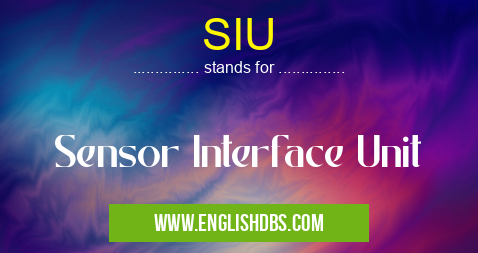What does SIU mean in MILITARY
An SIU, or Sensor Interface Unit, is a device that is designed to connect sensors and other monitoring equipment to digital systems. This unit is especially widespread in government and military applications where its reliability and accuracy are paramount. The interface allows for the monitoring of different parameters that may be important for various operations. It also ensures that these measurements are being correctly monitored and recorded for further analysis. In this way, SIUs offer an invaluable tool for governments and militaries when it comes to fast and accurate measuring of large amounts of data.

SIU meaning in Military in Governmental
SIU mostly used in an acronym Military in Category Governmental that means Sensor Interface Unit
Shorthand: SIU,
Full Form: Sensor Interface Unit
For more information of "Sensor Interface Unit", see the section below.
» Governmental » Military
What Does an SIU Do?
As described earlier, an SIU provides a connection between sensors or other monitoring instruments and digital systems. An SIU can evaluate various parameters such as speed, temperature, pressure, vibration, humidity, distance, or even light. Furthermore, they allow the user to set configurations so as to establish thresholds or limits of tolerance depending on the situation at hand. With this ability to configure settings and analyze readings accurately lets governments better collect data about different processes in their operations. Additionally, if any parameters go over established thresholds their status can be quickly reported allowing for quick action regarding response or maintenance needed.
In addition to providing digital connections with sensors and other monitoring instruments, most SIUs can also provide both analog as well as serial communication signals (RS-485). This allows for greater flexibility when configuring systems with compatible networks or devices from different manufacturers which removes the limitation of having a single vendor source all components for critical systems.
Advantages of SIU
The use of Sensor Interface Units brings several advantages thanks to its reliable digital output that provides stable readings for further analysis by a computer system or network if needed. This stability is key in government applications as it helps reduce errors caused by unreliable information which can lead to inaccurate decisions during emergencies or strategic situations among others where such mistakes can have disastrous consequences. Furthermore, they help minimize overall costs since a single unit is able to continuously monitor several sensors from critical locations at once instead of having separate units each receiving inputs from different sensors nearby thus decreasing operational costs in the long run. Finally thanks to their power efficiency compared with similar units this type of hardware are not only cost effective but also energy efficient which makes them great investments because their batteries will generally last longer than those used in similar devices while requiring fewer changes or replacements.
Essential Questions and Answers on Sensor Interface Unit in "GOVERNMENTAL»MILITARY"
What is a Sensor Interface Unit (SIU)?
A Sensor Interface Unit (SIU) is a system that bridges the gap between sensors and control systems. The SIU accepts signals from sensors, performs any necessary conversion, process them and send then out in a compatible output format to a control system or energy management system.
What are the benefits of using an SIU?
Using an SIU offers several tangible benefits. Firstly, the unit eliminates the need for multiple individual data converters by consolidating all of your sensor’s interfaces into one single solution. Secondly, it saves on wiring costs as you only need to connect one device instead of many. Additionally, an SIU can optimize performance by adding intelligence and providing diagnostic feedback within each interface.
How does an SIU work?
An SIU works by accepting inputs from various types of sensors, such as temperature, pressure or flow devices. It converts these signals into digital values that can be understood by control systems. The converted signals can also be further processed depending on the application before being sent out to control systems or energy management systems subsequent use.
What type of information does an SIU provide?
An SIU provides information related to the sensor input such as date and time stamps for each reading as well as status information about each individual measurement such as minimum/maximum readings and average values over certain periods.
What type of output formats do these units offer?
Most Sensor Interface Units offer compatible outputs with Modbus RTUs (remote terminal units), Profibus DPV0, EtherCAT or CANopen protocols that are widely used in industrial applications.
Are there any safety features in an SIU?
Yes. Usually when using hazardous substances such as flammable gas or combustible dusts within Industrial Control Systems context safety controls must be implemented accordingly. To address these issues most modern sensor interface units come with built-in safety features like active monitoring for power failures and emergency shutdown outputs on critical parameters.
